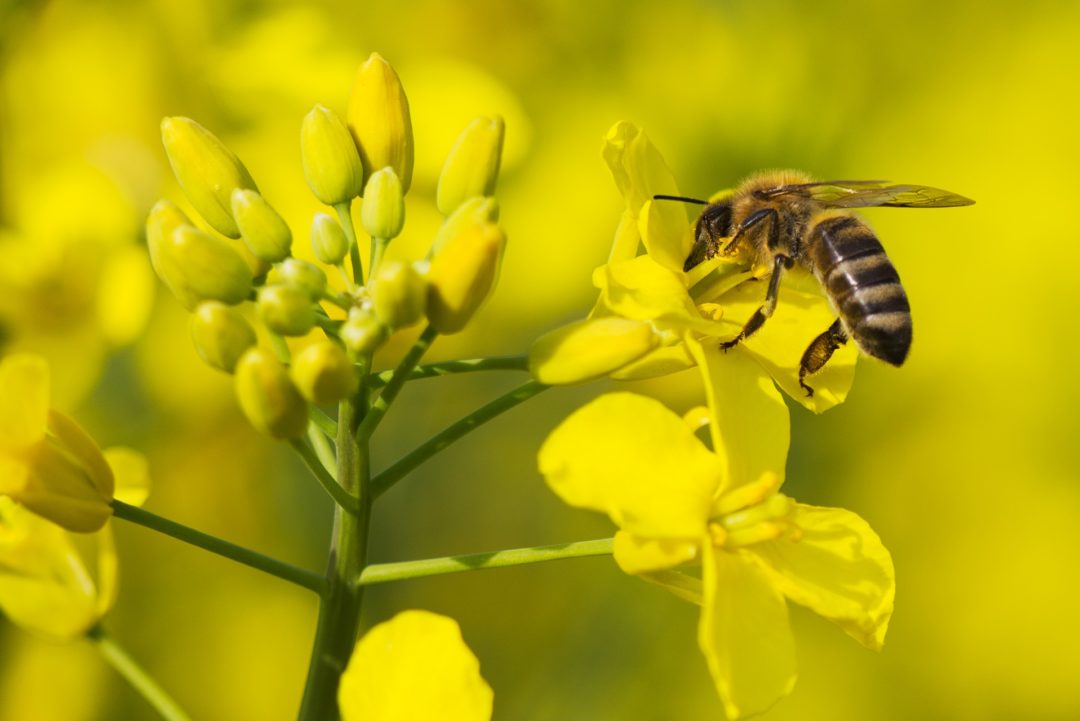
Study Reveals Neonics Harm Bees in Areas with Less Biodiversity

The study involved bees and neonics, which are generally coated on seeds like corn and soybean seeds before planting. Scientists examined different types of bees: honeybees and two types of wild bees at 33 sites across Europe including the United Kingdom, Germany and Hungary. The bees were placed near large fields of canola. Some contained canola grown from seeds while others were treated with neonicotinoid pesticides and standard fungicide. Lastly, some fields were planted with canola treated with fungicides.
In Hungary and the United Kingdom, bees that fed on neonic-treated canola fields turned out worse than bees that got to live around untreated canola. The results showed that when the bees were exposed to neonics, they had more trouble reproducing and surviving in the winter. Pywell called the results a “cause for concern.”
But interestingly enough, the results also revealed a complex outcome. In field sites located in Germany, honeybees seemed to flourish being near canola fields treated with neonicotinoids, rather than diminish like in Hungary and the United Kingdom. Honeybee colonies actually produced more eggs and more larvae.
“We think this is a really interesting result,” said Pywell. “We believe that this goes some way toward explaining the inconsistency of previous (research results).”
According to Pywell, “We believe that other factors interact with neonicotinoid exposure to cause negative effects on honeybees and wild bees.” Pywell states that he is unsure that those additional factors may be because his experiment was not designed to examine them, but the experiment did lead to some clues.
The study revealed that honeybees in Germany managed to find a larger variety of flowers to feed on. According toThe Salt, which first described the study on NPR’s Morning Edition, “In Hungary and the United Kingdom, 40 or 50 percent of the pollen collected by honeybees was from canola; in Germany, it was only about 10 percent.” Pywell states that in Hungary, the bees were bounded by giant fields of canola and in the United Kingdom “because of modern farming, we've lost many of our wild flowers, so the crops are pretty much all that's there in the springtime.”
Besides Germany having a larger variety of flowers for the honeybees to feed on, honeybees in Germany were fairly free of parasites, compared to the bees in the United Kingdom and Hungary.
Bayer, a company that makes most neonicotinoid pesticides, highlighted in an email toThe Saltthat “the study shows that when hives are healthy and relatively disease free and when bees have access to diverse forage, neonics do not pose a danger to colony health.”
The study was funded partially by not only Bayer, but by another neonics manufacturer called Syngenta. Pywell says his team of researchers “operated very independently.” Clearly, the results were not all they were cracked up to be for Bayer and other neonic manufacturers but certainly nuanced enough for them to work with.
In addition to this study, a separate field study was done and also published inScience. A team of Canadian researchers measured the levels of neonicotinoid pesticides that honeybees were exposed to at several sites in Ontario and Quebec. Researchers compared the honeybee colonies that were located close to corn fields with those that were further away.
Amro Zayad, professor of biology at York University in Toronto stated “the first surprise was that bees were bringing in pollen that was contaminated with neonicotinoids for most of the growing season — three or four months. The next surprise was that most of the pollen, 99% of the pollen, was from wild plants. Not corn, and not soybeans.”
According toThe Salt, “Zayed says that apparently, neonic residues in farm fields get dissolved in groundwater, and some are taken up by the roots of wild plants.” Zayad and his fellow colleagues did not monitor bee health, but instead tried to duplicate this field exposure to neonics in experiments with laboratory bees.
Zayad and his colleagues discovered that bees exposed to neonicotinoids did not keep their hives as clean and lost their queen bee more often.
“The story for honeybees is complicated, but these two papers, taken together, are kind of the first field-level evidence that there can be measurable impacts on important aspects of colony development and colony survival in the field,” says Nigel Raine, a specialist on bees at the University of Guelph, in Ontario. Raine believes that these experiments have helped fill in the gaps from what scientists still don’t fully comprehend.
Raine believes that The European study shows just how complicated the bigger picture is. It shows, according toThe Salt“that pesticides like neonicotinoids affect bees, but also reveals the importance of other factors, too.”
Raine says “We shouldn't just focus on insecticides. They're part of the problem, but if we focus on that and then just say, ‘OK, we understand that now, the problem's fixed,’ I don't think that's right. We need to be clear about how we're managing landscapes, both agricultural and urban and more natural landscapes, to support healthy biodiversity of pollinators.”

The editorial team at WholeFoods Magazine has decades of experiences reporting on natural products industry news, trends, and more. This national, monthly business-to-business magazine has been published continuously for nearly 40 years (the magazine was founded in 1977, and has been owned by Wainer Finest Communications since 1984). It is the longest-tenured media outlet of its kind in the natural products industry. The editorial focus at WholeFoods Magazine is, and always has been, on informing and educating members of the natural products industry.
The Magazine
Information
About Us
NOTE: WholeFoods Magazine is a business-to-business publication. Information on this site should not be considered medical advice or a way to diagnose or treat any disease or illness. Always seek the advice of a medical professional before making lifestyle changes, including taking a dietary supplement. The opinions expressed by contributors and experts quoted in articles are not necessarily those of the publisher or editors of WholeFoods.







